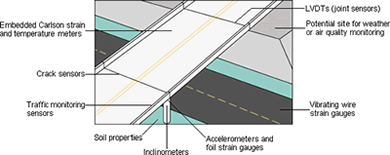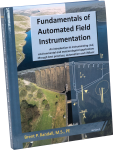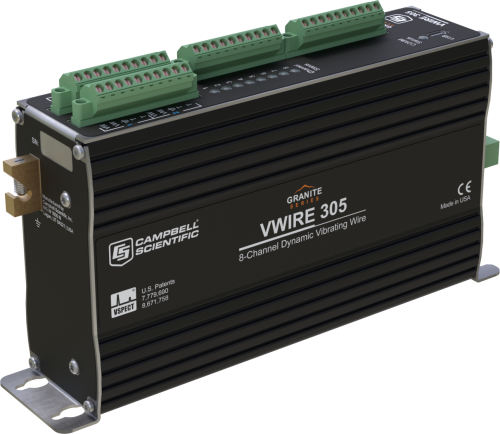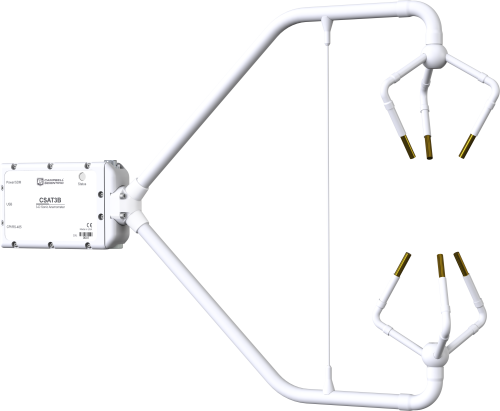Was wir tun
Campbell Scientific data-acquisition systems are used in structural and seismic monitoring projects ranging from simple beam-fatigue analysis to structural mechanics research to continuous monitoring of bridges and other large, complex structures. Unique to the Campbell Scientific approach to bridge monitoring is our patented spectral analysis (VSPECT®) technology that provides three advantages over the traditional time-domain method of reading vibrating-wire sensors:
- The highest measurement precision available for vibrating-wire sensors
- Sensor diagnostics to verify the performance and health of the sensors
- Measurement noise immunity, eliminating the need for post-processing of vibrating-wire sensor data
VSPECT technology allows vibrating-wire sensors to be read dynamically up to rates of 333 Hz, providing dynamic as well as simultaneous measurements across the entire structure.
Our systems are used globally in remote, unattended, stationary, and portable monitoring projects for highway overpasses, roads, tunnels, buildings, retaining walls, overhead signage, lighting towers, and bridges. They are compatible with a wide variety of sensors and peripherals to provide unparalleled measurements of either static or dynamic stress, vibration, displacement, load, and tilt. Incorporating various weather sensors, you can monitor dynamic structural behavior—such as wind-induced vibration, wave impact stresses, unsafe conditions, natural structural frequency, and harmonic structural frequencies—and send broadcast alerts. When life is at stake, there is no reason not to use the very best.
Learn about our patented VSPECT® spectral-analysis technology at our VSPECT® Essentials web resource.
The dynamic vibrating-wire measurement technique is protected under U.S. Patent No. 8,671,758, and the vibrating-wire spectral-analysis technology (VSPECT®) is protected under U.S. Patent No. 7,779,690.
Mehr erfahrenEin System maßschneidern
Zusätzlich zu unseren verfügbaren Standardsystemen bieten wir auch viele maßgeschneiderte Systeme an. Sagen Sie uns, was Sie brauchen, dann helfen wir Ihnen, ein System zusammenzustellen, das genau Ihren Bedürfnissen entspricht.
Ähnliche Produktkategorien
Weitere Details über unsere Brückenüberwachung Systeme
Bridges Monitored By Our Data Loggers
- James Joyce Bridge—Dublin, Ireland
- Bronx Whitestone Bridge—New York, NY
- Brooklyn Bridge—New York, NY
- Verrazano Narrows Bridge—New York, NY
- Williamsburg Bridge—New York, NY
- Throgs Neck Bridge—New York, NY
- Medway Bridge—Kent, UK
- Menai Bridge—North Wales
- Confederation Bridge—Prince Edward Island, Canada
- I-83 Ramp—Harrisburg, PA
- Birmingham Bridge—Pittsburgh, PA
- Sawmill Run Bridge—Pittsburgh, PA
- Neville Island Bridge—Pittsburgh, PA
- SR 33 Bridge—Easton, PA
- Girard Point Bridge—Philadelphia, PA
- Church Street Bridge—Melbourne, Australia
- David Trumpy Bridge—Queensland, Australia
- 15 Mile Creek Bridge—The Dalles, OR
- I-5 Mckenzie Bridge—Eugene, OR
- Willamette River Bridge—Willamette, OR
- I-64 over Kanawha River—Charleston, WV
- AMTRAK Susquehanna River Bridge—Perryville, MD
Bridge Monitoring and Control
The versatility of our systems allows them to be customized for each application. We offer a range of data loggers, from the most basic system with just a few channels to expandable systems that measure hundreds of channels. Scan rates can be programmed from a few hours to 100,000 times per second, depending on the data logger model. Measurement types, recording intervals, and processing algorithms, are also programmable. Data loggers not only provide advanced measurement capabilities, but can also control external devices.
Onboard processing instruction sets contain programmed algorithms that process measurements and output results in the desired units of measure. For example, data can be displayed as rainflow or level crossing histograms. These rainflow and level crossing algorithms allow processing for extended periods of time, not just a limited number of cycles. The instruction sets also allow for triggered output with pretrigger data capture capability. Triggers can be based on sensor output, time, and/or user control. For example, if an overpass is being monitored, data collection can be triggered by a sensor detecting the approach of a car, an earthquake, pre-programmed times, or by pushing a button.
The control functions of our data loggers combined with their programmability allow them to sound alarms, actuate electrical devices, or shut down equipment based on time or measured conditions. Systems can also call out to phones, pagers, radios, and other devices to report site conditions. Voice-synthesized modems are available, so the system can actually call and tell you what is happening.
Sensors used in Bridge Monitoring
Because our data loggers are compatible with nearly every commercially available sensor, you can use the sensors that best meet your application. Typical sensors used for structural and seismic monitoring by our systems include:
- Carlson strain meters
- vibrating wire strain gauges
- foil strain gauges (set up in quarter, half, or full bridge strain configurations)
- inclinometers
- crack and joint sensors
- tilt sensors
- piezoresistive accelerometers
- piezoelectric accelerometers
- capacitive accelerometers
- borehole accelerometers
- servo force balance accelerometers
Because our GRANITE™ Data-Acquisition Systems integrate with different measurement modules, each system has different channel types and programmable inputs. Channel types include analog (single-ended and differential), pulse counters, switched excitation, continuous analog output, digital I/O, and anti-aliasing filter. Using switched or continuous excitation channels, our data-acquisition systems provide excitation for ratiometric bridge measurements.
Our GRANITE Series allows you to customize a system with the channel types that best fit your application. The number and type of channels on most of our data-acquisition systems are expandable using multiplexers and other measurement peripherals.
Communications
The availability of multiple communications options for retrieving, storing, and displaying data also allows systems to be customized to meet exact needs. On-site communication options include direct connection to a PC or laptop, PC cards, storage modules, and data logger keyboard/display. Telecommunication options include short-haul, telephone (including voice-synthesized and cellular), radio frequency, multidrop, and satellite.
Software
Our Windows-based software simplifies data logger programming, data retrieval, and report generation. The data logger program can be modified at any time to accommodate different sensor configurations or new data processing requirements.
Example Application: Monitoring an Overpass
Campbell Scientific's monitoring systems are used for a variety of structural and seismic applications. Monitoring possibilities on an overpass include:

Dokumente
Broschüren Produkte
Anwendungsbeispiele
In the intricacies of transportation networks, bridges take center stage, knitting together communities and ensuring......lesen Sie mehr
Alfalfa is a thirsty crop. It uses more than 20 percent of all of the......lesen Sie mehr
The Shippingport Bridge spans the Ohio River in Beaver County, Pennsylvania. Constructed in 1961, the......lesen Sie mehr
On August 1, 2007, the I-35W St. Anthony Falls Bridge over the Mississippi River in......lesen Sie mehr
The four main spans of the Huey P. Long Bridge extend nearly 2,400 ft over......lesen Sie mehr
The Illinois Department of Transportation ran tests on twelve interstate highway bridges in Illinois along......lesen Sie mehr
Lehigh University researchers have been on the forefront of field instrumentation and testing of bridges,......lesen Sie mehr
Amidst a vast expanse of farming and range lands, bridge designers from the Montana Department......lesen Sie mehr
FAQs für
Number of FAQs related to Brückenüberwachung: 1
-
Most Campbell Scientific systems are built from individual components. This provides maximum flexibility for our customers, but it does not lend itself to pricing a "typical" system. Contact Campbell Scientific for assistance in pricing a system to meet the unique needs of the application.
Artikel und Pressemitteilungen
Privacy Policy Update
We've updated our privacy policy. Learn More
Cookie Consent
Update your cookie preferences. Update Cookie Preferences










